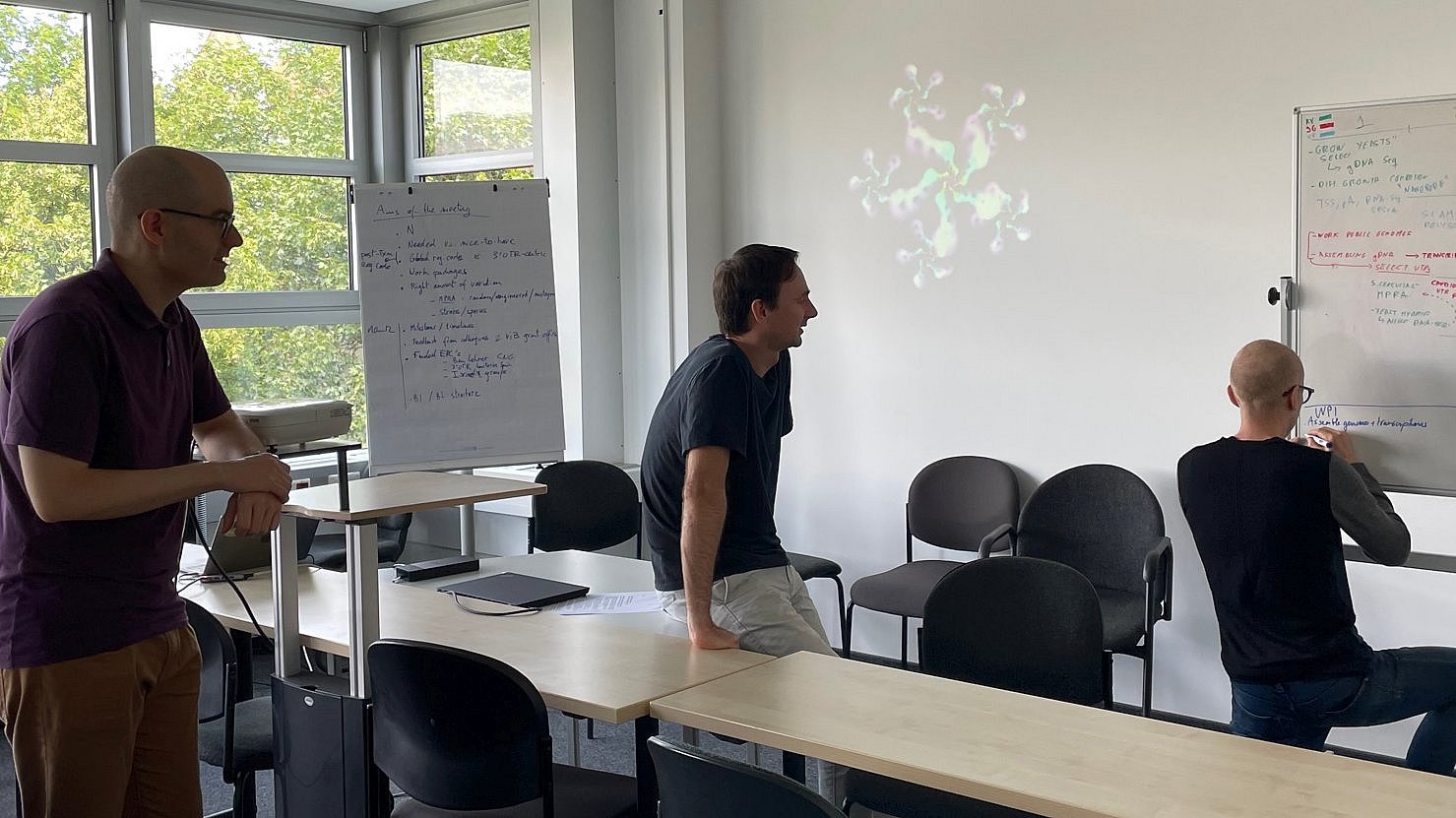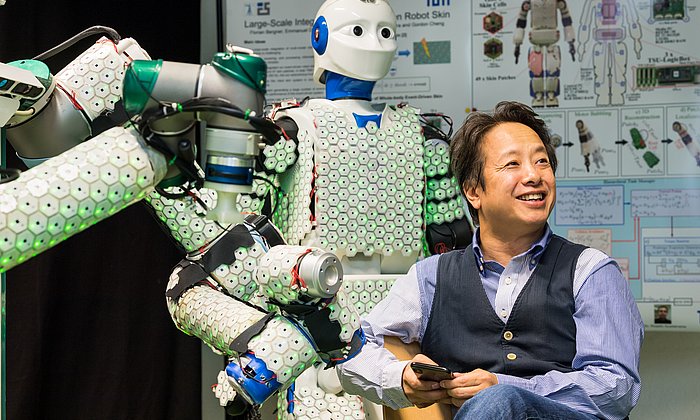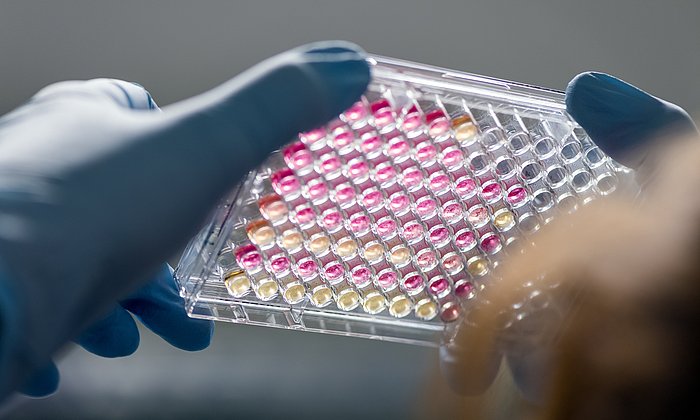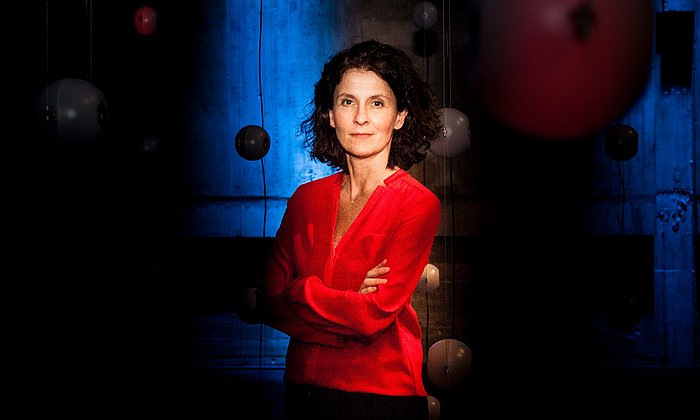ERC Synergy Grant for Prof. Julien Gagneur
A chatbot for gene regulation

Hello Kevin, Vicente, and Julien. First of all, we would like to congratulate you on receiving an ERC Synergy Grant. Can you tell us more about the project that convinced the ERC jury?
Kevin: Sure! As we all know, the genome encodes the instructions to regulate gene activity. This gene regulation involves two major steps. First, there is the transcription of genes to mRNA which is largely regulated by the promoter sequence. Second, post-transcriptional mechanisms take clues from codes in the 5’ and 3’ untranslated parts of the mRNA to regulate mRNA stability and the rate at which it is translated into proteins. Despite its importance for biology, medicine, and biotechnology, the underpinning regulatory code of this second step remains undeciphered. The lack of understanding of post-transcriptional regulation implies we still do not have a complete picture of how genes are regulated. In our EPIC project, we aim to unravel the eukaryotic post-transcriptional regulatory code.
Julien: Deciphering the language in which genomes are written, that is knowing the words and grammar and instructions made of A, C, G, and Ts encoding how cells should react to environmental changes, is a long-standing goal of biology. For no single organism so far, this regulatory code is fully cracked. But we are approaching a turning point, disruptive one may say, through the convergence of three major technologies: omics, AI, and synthetic biology. Omics encompasses an arsenal of high-throughput molecular assays that allow us to quantify every step of gene expression from DNA to protein abundance via the entire life cycle of RNAs; recent AI techniques have the scalability and flexibility to learn complex rules from massive data; and synthetic biology opens the path to synthesize artificial genes by the thousands – we will design nearly a million of them to systematically test and refine our model of the regulatory code and eventually design genes and cells for biotechnological applications.
I believe we convinced the jury by bringing together three groups at the edge of these three technologies – Vicente for the omics, myself for the AI, and Kevin for the synthetic biology – and proposing an integrated project that systematically attacks this fundamental problem.
Can you give us some insight on how you will do this exactly?
Vicente: We will combine innovative high-throughput technologies from my team at the Karolinska Institute to probe post-transcriptional regulation across a broad range of species and conditions with synthetic biology at the VIB-KU Leuven Center for Microbiology to massively modify and test regulatory sequences. Julien’s group then uses this as input to train machine learning models that predict the code. This information then flows back to the wet lab teams who set up additional experiments to verify the predictions and provide new data for another round of machine learning, and so on. Together, we end up with a chatbot (not unlike the by-now famous ChatGPT) for DNA; a model that can predict how a gene will be regulated, or how mutations will affect regulation, and which can even be used to suggest de novo regulatory sequences that can be used in biotechnology.
Kevin: We will exploit the advantages of the model eukaryote Saccharomyces cerevisiae and other yeast species covering a broad evolutionary range to derive the first comprehensive sequence-based model of eukaryotic gene regulation. An original aspect of EPIC is how much we will leverage evolution. As Theodosius Dobzhansky famously stated, nothing in biology makes sense except in the light of evolution.
Julien: Exactly! EPIC will assay one hundred species to leverage genomic sequences that have evolved over hundreds of millions of years; very informative data that is not random but selected. Our research group from the Technical University Munich will develop new AI models to effectively learn from such multi-species data. This will allow us to unravel complex regulatory instructions, build predictive models, and design genes with intended regulation.
Can you elaborate on the implications of this research for the scientific community? Maybe even in terms of potential applications?
Julien: EPIC will allow us to understand and predict gene regulation – and ultimately phenotype – from DNA. This will close a major gap in basic biology, while also opening exciting avenues for potential applications. Our new insights could, for example, be applied in biotechnology, from pinpointing disease-causing mutations to the rational design of genes, RNAs, and cells.
What does an ERC Synergy Grant mean to you as scientists?
Vicente: Of course, the financial aspect is important. Selected projects in a Synergy grant receive nearly ten million euros over six years. This financial support is crucial to realize breakthrough research on a big scale.
Kevin: Apart from allowing us to pursue our research questions and tackle this ambitious project together, the grant is also a nice testimony to the quality of our proposal. The ERC Synergy grants are notoriously competitive, with only an eight percent success rate. So, being picked is quite an honor.
Julien: The 'synergy' with experimentalists is extremely important because it allows me to tightly participate in the design of the experiments that feed the models but also in experiments testing the models. This gives our research an entirely new dimension that pure computational work does not have. And it’s the ERC, a unique funding program in which scientists from any discipline can propose any topic. Only with such a bottom-up and well-funded granting scheme can fundamental questions be tackled. This is exactly what we need now to make a breakthrough in cracking the regulatory code.
In a Synergy Grant, collaboration is important. Can you tell us a bit more about how this collaboration came about?
Kevin: Funnily, while the research in my lab is furthest removed from the topic, the basic idea came from me. Part of my lab is very active in the genetic engineering of yeast cells to produce food, biofuels, and pharmaceuticals sustainably. This implies that we insert foreign genes in the yeast genome, and try to optimize their expression. We mostly do this by putting the genes under the control of specific promoters, but we haphazardly noticed that the untranslated regions also had a massive influence on the regulation of the genes. I started reading up on this phenomenon and quickly realized how little we understand of this phenomenon. So, I reached out to Vicent and Julien, arguably some of the biggest experts in this area. The rest is history.
Vicente: When Kevin contacted us, it was clear that we could assemble a 'dream team' to think big and aim to do something EPIC.
Julien: I knew Vicente from our postdoc time at the EMBL, more than 10 years ago. We reconnected as if we only left each other the day before. There were also immediately good vibes with Kevin. It was clear we could work well together and shoot for something big.
The Synergy Grant is quite prestigious and challenging to get. Do you have any tips, tricks, or suggestions for your peers who are aiming for this grant in 2024?
Kevin: First and foremost, do not be afraid to go for a very ambitious project.
Vicente: Then, make sure you have the best experts to tackle the research, but also keep the team limited to exactly those people who are needed. All PIs should have complementary expertise and be truly essential.
Julien: Finally, put a lot of effort into the preparations! Luckily, we could count on the help of several people in our groups as well as the critical input of colleagues. At the TUM, this triggered to a new collaboration with Prof. Philipp Benz, expert in fungal biotechnology, with whom we will work within EPIC. And have fun!
A Synergy grant is awarded to a team of researchers. How did you tackle the challenging process of writing a grant together with 3 PIs?
Julien: This was indeed an important aspect. We discussed the outline of the project in several online meetings. Importantly, after that, we also organized several in-person meetings to further brainstorm, tweak the proposal, and align on practical aspects of the grant. For small questions, we had a very active Slack channel.
Vicente: We also organized weekly ‘ERC Coffee’ meetings – just 10-15 min to discuss progress and the most pressing matters. This proved to be very useful and really helped to get the best possible proposal!
Thanks for sharing this, and thank you for the nice interview!

- So far, a total of two ERC Synergy Grants have gone to TUM researchers. Teams of two to four scientists can apply for the ERC Synergy Grant. The interdisciplinary projects should lead to new discoveries at the interfaces between research fields. The maximum funding amount per project is 10 million euros.
European Research Council (ERC) - Researchers at TUM have so far been able to acquire 201 of the prestigious ERC grants. These are awarded each year in various categories. In addition to the ERC Synergy Grants, research projects are funded by the ERC with Starting Grants, Consolidator Grants, Advanced Grants and Proof of Concept Grants.
ERC Grants at TUM - Prof. Julien Gagneur came to TUM as an assistant professor in 2016. In 2020, he took over the Chair of Computational Molecular Medicine. His research is on the genetic basis of gene regulation and its effects on diseases using statistical algorithms and machine learning. He is also a research group leader at Helmholtz Munich.
Contacts to this article:
Prof. Dr. Julien Gagneur
Technische Universität München
Professur für Computational Molecular Medicine
Tel: +49 (89) 289-19411
julien.gagneur@tum.de



